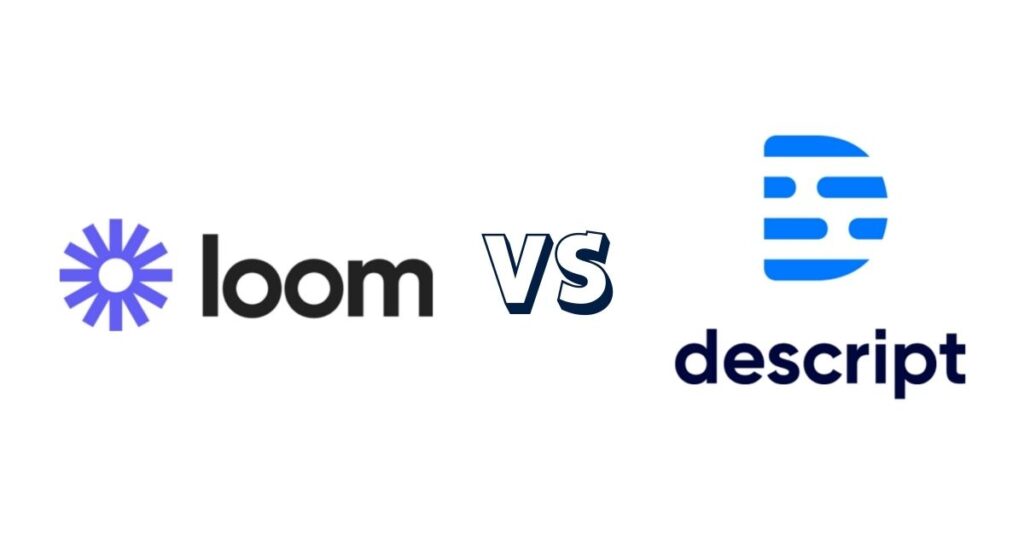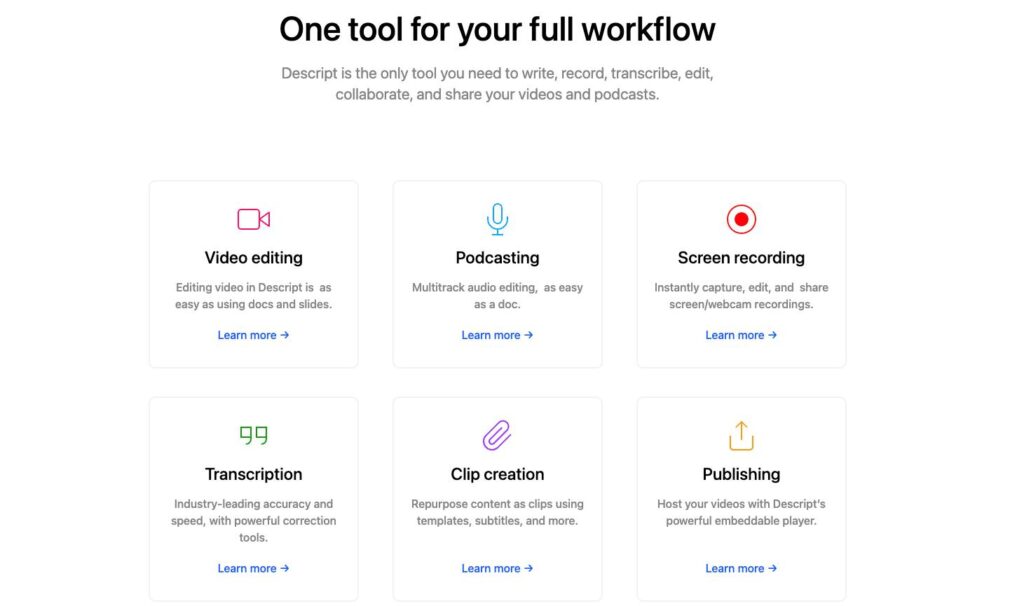
Looking for loom vs descript? In the digital age, where communication relies heavily on multimedia content, choosing the right tools for audio and video creation is paramount. Two popular contenders in this space are Loom and Descript. In this comprehensive guide, we’ll delve into the intricacies of each platform to help you make an informed decision based on your specific needs.
As our reliance on visual and auditory content grows, selecting the right platform becomes crucial. Enter Loom and Descript, both offering unique features for audio and video creation. Whether you’re a content creator, educator, or business professional, understanding the nuances of these tools is essential for effective communication.
Table of Contents
Understanding Loom
What is Loom? Loom is a versatile video messaging platform designed for quick and easy communication. Its primary strength lies in its simplicity; with just a few clicks, users can record, edit, and share videos.

Key Features of Loom:
- Instant Recording: Loom facilitates on-the-fly video creation with its easy-to-use recording feature.
- Annotation Tools: Users can enhance their videos with annotations, drawings, and emphasis on specific elements.
- Integration Capabilities: Loom seamlessly integrates with various applications, enhancing its utility in diverse workflows.
Use Cases of Loom: Loom finds applications in:
- Remote Collaboration: Quick video messages foster efficient remote collaboration.
- Educational Content: Teachers use Loom for creating engaging instructional videos.
- Customer Support: Businesses leverage Loom for personalized customer support responses.
Pros and Cons of Loom:
| Pros | Cons |
|---|---|
| User-Friendly Interface | Limited Advanced Editing Features |
| Quick Video Creation | Basic Analytics |
| Integration with Productivity Apps | Limited Storage Options for Free Users |
Understanding Descript
What is Descript? Descript is an all-encompassing audio and video editing tool that boasts advanced features, making it a go-to choice for those seeking more robust capabilities.

Key Features of Descript:
- Transcription and Editing: Descript allows users to edit audio and video by editing the text transcription directly.
- Advanced Editing Tools: Users can make nuanced edits, including removing filler words and awkward pauses.
- Automatic Transcription: The platform automatically transcribes spoken words, enhancing accessibility and searchability.
Use Cases of Descript: Descript excels in:
- Podcast Editing: Podcast creators benefit from Descript’s advanced editing for a polished final product.
- Professional Video Editing: Video producers appreciate the detailed control over content provided by Descript.
- Transcription Services: The automatic transcription feature caters to those needing accurate written records of spoken content.
Pros and Cons of Descript:
| Pros | Cons |
|---|---|
| Advanced Editing Capabilities | Learning Curve for New Users |
| Automatic Transcription | Resource-Intensive for Large Files |
| Precise Audio and Video Control | Higher Price Point for Full Feature Access |
Head-to-Head Comparison: Loom vs Descript
User Interface
Loom Interface: Loom boasts a minimalist interface, ideal for those seeking quick and straightforward video creation. The focus is on simplicity, making it accessible even for beginners.
Descript Interface: Descript’s interface is more feature-rich, catering to users who require detailed control over their audio and video content. The learning curve is steeper but rewarding for those seeking advanced editing capabilities.
Ease of Use
Loom: With its intuitive design, Loom is known for its ease of use. Recording and sharing videos are seamless processes, making it an excellent choice for those prioritizing simplicity.
Descript: Descript, while more complex, offers a comprehensive editing experience. Its learning curve is balanced by the depth of control it provides, making it suitable for users with specific editing needs.
Pricing Models
Loom: Loom offers a freemium model with basic features available for free. Paid plans unlock additional features and storage options, catering to both casual users and businesses.
Descript: Descript follows a subscription-based model. While it comes with a higher price point, the investment may be justified for those requiring advanced editing features.
Accessibility
Both Loom and Descript are accessible on various platforms, including web browsers and mobile applications. However, Loom’s simplicity may give it a slight edge for users who prioritize quick access and on-the-go recording.
Performance and Functionality
Video and Audio Quality
Loom: Loom provides decent video and audio quality suitable for most communication needs. It prioritizes speed and convenience over top-tier production quality.
Descript: Descript allows for high-quality audio and video output, making it an ideal choice for those who prioritize professional-grade content.
Editing Capabilities
Loom: Loom’s editing capabilities are more basic, focusing on quick edits and annotations. It’s suitable for users with straightforward editing requirements.
Descript: Descript shines in the editing department, offering advanced features for meticulous content creators. Its transcription-based editing sets it apart for those who require precision.
Integration with Other Tools
Both platforms integrate with various applications, enhancing their utility in different workflows. Loom’s seamless integration makes it easy for users to incorporate video messaging into their existing communication tools. Descript, with its focus on professional editing, integrates effectively with other creative tools and software.
Collaborative Features
Loom: Loom supports basic collaborative features, allowing users to share videos and collaborate in real-time. It’s suitable for small to medium-sized teams.
Descript: Descript’s collaborative features shine when it comes to detailed editing tasks. Teams working on intricate audio and video projects will benefit from its collaborative functionalities.
Customer Support and Resources
Customer Support Options
Both Loom and Descript offer customer support through help desks, live chat, and extensive tutorials. Loom’s user-friendly interface often leads to fewer support queries, but both platforms are responsive to user needs.
Community Forums
Loom and Descript have active user communities, where individuals share tips, troubleshoot issues, and discuss creative uses of the platforms. Engaging in these forums can provide valuable insights and solutions for users of both tools.
Training Resources
Loom and Descript provide training resources, including tutorials and documentation. Loom’s emphasis on simplicity is reflected in its straightforward tutorials, while Descript’s learning materials cater to users seeking in-depth knowledge on advanced editing techniques.
Real-World User Experiences
User Testimonials
Loom: Users appreciate Loom’s quick video creation capabilities, citing its simplicity as a major advantage. It is often lauded for its efficiency in remote communication and collaboration.
Descript: Descript users commend its advanced editing features, especially its transcription-based approach. Content creators value the precision it offers in polishing audio and video content.
Case Studies
Loom: Case studies highlight Loom’s effectiveness in diverse settings, from education to business communication. The platform’s versatility shines in scenarios where quick, visual communication is paramount.
Descript: Descript’s case studies often focus on its role in elevating content quality, showcasing how meticulous editing can enhance the impact of podcasts, videos, and other multimedia content.
Online Reviews
Both Loom and Descript enjoy positive online reviews, but user preferences vary based on their specific needs. Loom is praised for its accessibility and speed, while Descript receives accolades for its editing prowess and nuanced control.
Future Developments and Updates
Roadmaps
Loom: Loom’s roadmap emphasizes improvements in user experience and additional integrations. The platform aims to maintain its position as a quick and efficient video messaging tool.
Descript: Descript’s roadmap focuses on enhancing its editing capabilities, with a commitment to staying at the forefront of advanced audio and video editing tools.
Updates and Improvements
Both platforms consistently roll out updates, addressing user feedback and incorporating new features. Staying abreast of these updates is crucial for users looking to leverage the latest advancements in audio and video creation.
Conclusion
In the eternal debate of Loom vs. Descript, the choice ultimately depends on your specific needs. If you prioritize quick, accessible video messaging with a user-friendly interface, Loom is the go-to option. On the other hand, if you demand advanced editing features and precise control over your audio and video content, Descript emerges as the frontrunner.
Remember, each platform has its strengths, and your decision should align with your unique requirements and preferences. Whether you opt for the simplicity of Loom or the depth of control provided by Descript, both platforms contribute significantly to the evolving landscape of digital communication.
Additional Resources and References
For more in-depth information and to explore each platform further, visit the official websites of Loom and Descript. Additionally, check out the following resources:
If you’re curious about the power of Descript and want to dive into in-depth reviews, check out our detailed exploration at Descript Reviews: Unveiling the Power of Descript. Discover how Descript stands out in the realm of audio and video editing, and gain valuable insights from user experiences and testimonials.
XI. Acknowledgments
Thank you for joining us on this exploration of Loom and Descript. Feel free to share your insights and experiences on social media, and let’s continue the conversation around the evolving landscape of audio and video creation.
FAQs: Loom vs Descript
Who competes with Loom?
Loom faces competition from various video messaging platforms, including Zoom, Microsoft Teams, and CloudApp. Each platform caters to different user needs, and the choice depends on factors such as simplicity, collaboration features, and integration capabilities.
Is Descript a good screen recorder?
Descript offers screen recording capabilities, making it a versatile tool for content creators. While it may not be the primary focus of the platform, users appreciate Descript’s ability to seamlessly integrate screen recordings into their audio and video projects.
Is Descript a good editing software?
Yes, Descript is considered an excellent editing software, especially for those who prioritize advanced editing capabilities. Its unique transcription-based approach to editing sets it apart, providing users with precise control over their audio and video content.
Is Loom a good software?
Loom is widely regarded as a good software, particularly for its simplicity and efficiency in quick video messaging. It excels in scenarios where users need to communicate visually and collaboratively in a straightforward manner.

